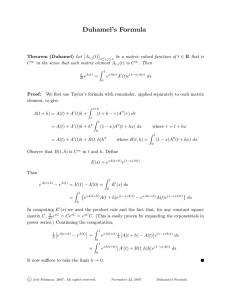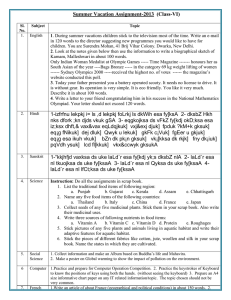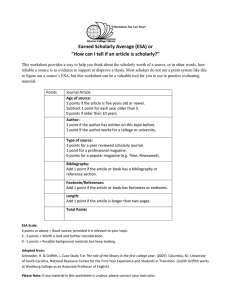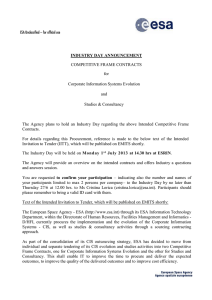M. Hesham NASR Egyptian Survey Authority, Egypt ( )
advertisement
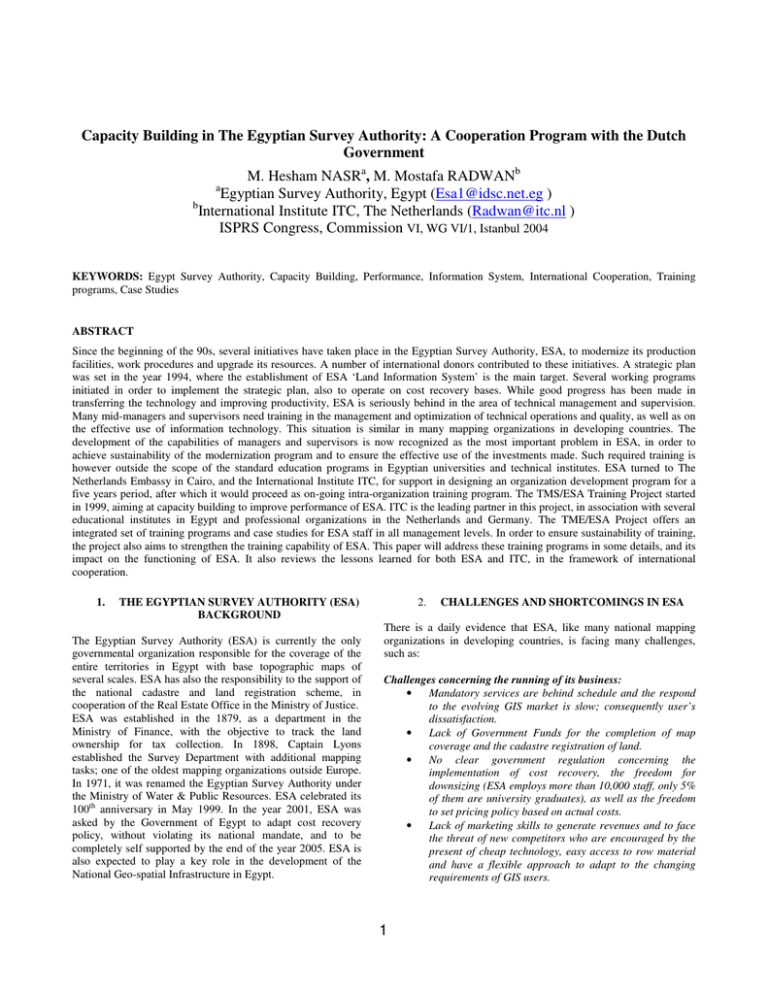
Capacity Building in The Egyptian Survey Authority: A Cooperation Program with the Dutch Government M. Hesham NASRa, M. Mostafa RADWANb a Egyptian Survey Authority, Egypt (Esa1@idsc.net.eg ) b International Institute ITC, The Netherlands (Radwan@itc.nl ) ISPRS Congress, Commission VI, WG VI/1, Istanbul 2004 KEYWORDS: Egypt Survey Authority, Capacity Building, Performance, Information System, International Cooperation, Training programs, Case Studies ABSTRACT Since the beginning of the 90s, several initiatives have taken place in the Egyptian Survey Authority, ESA, to modernize its production facilities, work procedures and upgrade its resources. A number of international donors contributed to these initiatives. A strategic plan was set in the year 1994, where the establishment of ESA ‘Land Information System’ is the main target. Several working programs initiated in order to implement the strategic plan, also to operate on cost recovery bases. While good progress has been made in transferring the technology and improving productivity, ESA is seriously behind in the area of technical management and supervision. Many mid-managers and supervisors need training in the management and optimization of technical operations and quality, as well as on the effective use of information technology. This situation is similar in many mapping organizations in developing countries. The development of the capabilities of managers and supervisors is now recognized as the most important problem in ESA, in order to achieve sustainability of the modernization program and to ensure the effective use of the investments made. Such required training is however outside the scope of the standard education programs in Egyptian universities and technical institutes. ESA turned to The Netherlands Embassy in Cairo, and the International Institute ITC, for support in designing an organization development program for a five years period, after which it would proceed as on-going intra-organization training program. The TMS/ESA Training Project started in 1999, aiming at capacity building to improve performance of ESA. ITC is the leading partner in this project, in association with several educational institutes in Egypt and professional organizations in the Netherlands and Germany. The TME/ESA Project offers an integrated set of training programs and case studies for ESA staff in all management levels. In order to ensure sustainability of training, the project also aims to strengthen the training capability of ESA. This paper will address these training programs in some details, and its impact on the functioning of ESA. It also reviews the lessons learned for both ESA and ITC, in the framework of international cooperation. 1. THE EGYPTIAN SURVEY AUTHORITY (ESA) BACKGROUND The Egyptian Survey Authority (ESA) is currently the only governmental organization responsible for the coverage of the entire territories in Egypt with base topographic maps of several scales. ESA has also the responsibility to the support of the national cadastre and land registration scheme, in cooperation of the Real Estate Office in the Ministry of Justice. ESA was established in the 1879, as a department in the Ministry of Finance, with the objective to track the land ownership for tax collection. In 1898, Captain Lyons established the Survey Department with additional mapping tasks; one of the oldest mapping organizations outside Europe. In 1971, it was renamed the Egyptian Survey Authority under the Ministry of Water & Public Resources. ESA celebrated its 100th anniversary in May 1999. In the year 2001, ESA was asked by the Government of Egypt to adapt cost recovery policy, without violating its national mandate, and to be completely self supported by the end of the year 2005. ESA is also expected to play a key role in the development of the National Geo-spatial Infrastructure in Egypt. 2. CHALLENGES AND SHORTCOMINGS IN ESA There is a daily evidence that ESA, like many national mapping organizations in developing countries, is facing many challenges, such as: Challenges concerning the running of its business: • Mandatory services are behind schedule and the respond to the evolving GIS market is slow; consequently user’s dissatisfaction. • Lack of Government Funds for the completion of map coverage and the cadastre registration of land. • No clear government regulation concerning the implementation of cost recovery, the freedom for downsizing (ESA employs more than 10,000 staff, only 5% of them are university graduates), as well as the freedom to set pricing policy based on actual costs. • Lack of marketing skills to generate revenues and to face the threat of new competitors who are encouraged by the present of cheap technology, easy access to row material and have a flexible approach to adapt to the changing requirements of GIS users. 1 Challenges concerning the management of information: • Lack of ‘well structured’ Information System, based on database technology, as no financial/human capacity to build. • No mechanism (and associate standards and regulations) to provide direct access to geoinformation available in other related organizations. Challenges concerning the management of technical operations and quality of services: • Lack of flexible production methodologies for the production of up-to-date maps/information and diverse products, just-on-time, and tailored to customer needs. • Lack of skills in the effective use of digital technology and modern concepts for technical operations management. • Lack of sound methodology and the supporting systems to manage quality of services, performance of technical operations and workflows, costs and resources. 3. the land registers. Several projects were initiated, in the framework of the implementation of the Strategic Plan, to finalize the registration of ownership and cadastre maps in rural areas (first priority), to be followed by similar projects in urban areas in cooperation with the Local Authorities in the various cities in Egypt. Since then, ESA is now focusing on key improvement actions to speed up the implementation of the Strategic Plain. In the following, we mention only those actions, which will have impact on capacity building and the required staff training: 3.2. Areas of focus for improvement • ESA is on the process of change to operate on economic bases, without violating its national commitment. ESA will continue to support map coverage and the registration of land and the provision of basic land information as required for good governance in all administrative levels in Egypt. Such change is part of the Egyptian Government policy to change most of government organizations offering (almost) free services to operate on ‘costrecovery’ bases, as a step toward complete privatization. Of some of these organizations. • ESA is revising its management style and the way of conducting business. The objective is to optimize the use of resources, improve the quality of services and maximize revenue. Several options will be setup to maximize the role of information technology in improving the responsiveness of ESA to market change. This needs the diversity of products and services according to market demands, the re-engineering of its production workflow to improve operations management, the establishment of Land Information System and introduction of a quality management system in all sectors and management levels. An ‘activity based costing ABC’ models will be developed for the various services and products in order to help ESA to link the ‘spending’ with the ‘achievement’ of the various sectors, as well as to set its ‘pricing policy’ and the bases for achieving ‘cost-recovery’. • ESA will establish its Land Information System, to support cadastre services and topographic mapping as well as the generation of value-added products. The system is composed of several databases, distributed in the various locations in ESA, the Head Quarter, the Topographic Sector, the Provinces as well as the District Cadastre Offices. The system will be integrated, both conceptually and physically, to insure data integrity and data sharing. The various institutional aspects that are relevant to the development of such a system are under investigation, such as information policy and copy rights, standards, business domains to be supported, costs and prices, upgrading of IT resources and human skills, etc. The decision on the contents of these databases (type and size of data) will be made according to demands. The same principle will be applied on the completion of the map coverage and publication of the various map scales. As a step towards the creation of such a system, several projects will be initiated very soon in the Provincial Offices to convert existing data sources (cadastre maps and documents) into digital form and store them in databases; the objective is to complete ‘El-Sagel El- THE MODERNIZATION PROGRAM IN ESA 3.1. Modernization activities: The Government of Egypt and a number of international donors invested more than US$ 50 million in the past 15 years for the technical modernization of ESA. Examples of such international aid projects are: • The Finnish Projects in the 80th and the 90th, with the objective to complete the map coverage in areas outside the Nile Valley. • The German Project in the early 90th, with the objective to develop a cadastre System in the Province of Aswan. • The USAID technical Aids Project in the early 90th, with the objective to modernize the topographic & cadastral mapping systems in ESA, including the upgrading and modernization of resources and the establishment of production procedures, conducted in several pilot projects for mapping and cadastre land registration. • The French Project in the year 2000, with the objective to introduce remote sensing techniques for topographic mapping in desert areas. • The Finish Project in the year 2002, with the objective to develop methodology for the establishment of cadastre information system in the Province of El-Behara. • The Dutch Project in the years 2000 – 2004, with the objective to support capacity building in ESA. This project is the main topic of this paper. This modernization is now entering its tenth year and has provided up-to-date equipment, technical training and production support in a number of pilot areas. The modernization program is supported by the development of Strategic Plan in 1994 for the completion of map coverage and 2 Aeny’, the national cadastre. Some of these projects will be conducted in co-operation with foreign companies • The modernization of the various supporting services for the management of finance, personnel, stores, sales, resources, project planning and management, secretarial work, etc. is a complementary part to these development to support strategic planning and organizational management. • ESA is aiming to be the focal point for the development of the National Geo-spatial Information Infrastructure in Egypt. 3.3. The impact on the approach for capacity building and the training of staff As a result of the considerable increase in technological and technical capabilities at ESA, the quantity of work that can be processed has increased. This increase in output needs to be met by a similar improvement in quality and output of the specialized line managers and supervisors required to manage the modernized production processes. While good progress has been made in transferring the technology and improving productivity, ESA is seriously behind in the area of technical management and supervision. Many mid-managers, who are expected to play an important role in ESA modernization program, need an adequate training in the management and optimization of technical operations and quality, as well as on the effective use of information technology. The development of the capabilities of managers and supervisors is now recognized as the most important problem in ESA, in order to achieve sustainability of the modernization program and to ensure the effective use of the investments made. The ESA Management has made its solution his first priority. The Ministry of Public Works and Water Resources, under which ESA exists, and with which a very large segment of the Netherlands’ bilateral development co-operation program is being executed, has provided its full support for the priorities of ESA. 4. THE TMS/ESA PROJECT FOR CAPACITY BUILDING IN ESA 4.1. Executive summary The TMS/ESA Project is a ‘Training Program for the Development of Managers and Supervisors for the National Cadastre and Topographic Mapping’ in ESA. The TMS/ESA Project aims to institutional support and capacity building in ESA to improve performance and the quality of services in the various sectors in ESA, particularly in relation to implementing an ‘economic-oriented’ policy. Several training programmes in managing technical operations, projects and resources, are provided by the project in Egypt and the Netherlands, for the staff members of ESA from all management levels. Case studies and pilot projects are included to apply the taught concepts in the various sectors in ESA. The project will also provide institutional and technical supports to the training facilities in ESA in order to insure the sustainability of the training programs, which are introduced by the project. Approximately 850 managers and supervisors at ESA require training. By training this number of staff, the sustainability of the designed training system is assured by building a strong team that will be able to pass on their skills and knowledge to a much wider group of managers within ESA. Over the total five-year combined project period, general management training would have been provided in Egypt for 200 managers and supervisors. Technical operations management training will be conducted for up to 120 first- and second-level managers and supervisors from lower and middle management cadres, using a series of specially developed technical management training modules. Further, ESA’s training program Development Office (TPDO) will be strengthened. Training managers and trainers will be developed and courses designed, implemented and refined before being handed over. Training facilities will be refurbished and improved, and training equipment provided. On-the-job support from experienced Dutch and Egyptian trainers will be initially provided during the project. The support program is specially designed to ensure that ESA is able to continue and sustain the training program in the future. An Association consisting of ITC (International Institute for Geoinformation Science and Earth Observations leading partner) and MSM (Maastricht School of Management) will implement the proposed project. These two academic institutes are supported by two European professional organizations, the Dutch Cadastre and the German Survey and Mapping Agency, Nordrhein-Westfalen, NRW. Further, local teaching staff from Egyptian institutes RITI (Regional Information Technology Institute), CACE-AUC (American University of Cairo) and Cairo University will participate in the project. The TMS/ESA Project will be executed in 5 years (1999 – 2004), and funded mainly by the Netherlands Government in the framework of the cooperation protocol between Egypt and the Netherlands; the allocated budget is 2.5 million Euros. The ITC and ESA also offer a considerable financial contribution to the various activities in the project; ITC offers an amount of 200,000 Euro (in form of training fellowships in ITC courses and teaching material) and ESA contributed by an amount of 600,000 Euro (in the form of raining resources). The total project budget is about 3.3 million Euros. 4.2. General objectives of the project The general objectives of the project may be summarized as: • • • • • 3 To provide institutional support and a sustainable training program to upgrade operations and general management skills of ESA first-line managers and supervisors, and to upgrade the knowledge of top and mid management; Improve and strengthen the training department at ESA and create a pool of capable trainers to sustain courses developed under the project; Create and run specialized training programs in Egypt in general management as well as technical management; Provide courses in technical management training in the Netherlands for middle managers; Run seminars for senior management staff in Cairo and in the Netherlands; • Develop de-centralized regional facilities in Egypt for the training of staff from neighboring Arab Countries. 4.3. Training activities in the project The project offers an integrated package of training programmes, to be executed in Egypt and the Netherlands. The objective is to satisfy the overall requirement of the various key target groups in the various sectors in ESA. Program ‘P1’: Training courses for ESA Senior Staff and Top Managers, in the handling of strategic issues and managing the performance of ESA. This training is conducted in the form of workshops and seminars in Egypt. Some of these workshops were dedicated to bridge the gap between staff from the topand mid-management levels. A selected number of the senior staff (8 staff members per year) visits professional organizations in the NL and Germany, to learn from their experience. Program ‘P2’: Training courses and advanced studies for ESA staff members who will be responsible for the development of ESA production systems and the introduction of modern concepts in technical operations management. Some of these graduates will be the ‘first line’ trainer in ESA in various training programs in the project. The training in this Program takes place in ITC, MSM and professional organizations in NL and Germany. in ESA and supervised by staff members from ITC and the Dutch Cadastre from NL. Program ‘P8’: Provision of teaching skills for ESA’s first-line trainers (some of the graduates of the ‘P2’ and ‘P3’ Programs). The staff members of the Training Department in ESA are also trained in developing and managing of training Programs. This training is provided by specialized institutes in Egypt, and supervised by ITC Education Specialists from NL. Program ‘P9’: Training in English language and Digital mapping Techniques. This training is provided by specialist institutes in Egypt to prepare candidates for the various training programs in the Project. The goals and the teaching activities within each of these programs are described in details in the TMS/ESA Project document and the Course Calendars. 4.4. Training target: By the end of the Project 5 years duration, the following number of ESA staff; senior and top managers, mid-managers and supervisors, senior technicians and training supervisors, should be trained in the various training programs in the project: Program / 96-99 Program ‘P4’: Training course for supervisors and mid managers in technical operations management. This training is provided in Egypt by staff members from ITC, MSM and professional organizations from the NL and Germany, supported by several teaching staff from local universities in Egypt. ESA’s trainers (the graduates of the ‘P2’ and ‘P3’ Programs) take an increasing teaching role in this training. Program ‘P6’: General Management Courses for all senior and mid-managers in ESA. This training is provided by specialized institutes in Egypt and supervised by MSM staff from NL. Program ‘P7’: Development of case studies and pilot projects to apply the taught subjects in the various sectors in ESA. The graduates of the ‘P2’, ‘P3’, ‘P4’ and ‘P5’ Programs contribute in these activities. Examples of these case studies are the development of information system and associate databases, quality management system, design of urban cadastre, cost models, etc. These case studies are conducted in some sectors P2 P3 P4 P5 P6 P7 P8 P9 Year Program ‘P3’: Training courses for supervisors and mid managers in ITC standard courses, plus an attachment to professional organizations to be trained in the management of technical operations. The training in the program takes place in ITC and professional organizations in NL and Germany. Program ‘P5’: Training senior technicians in the requirements for the optimum use of technology and the execution of workflow. ESA trainers, supervised by ITC staff from NL, provide this training. P1 10 16 2000 30 8 6 16 60 16 2001 30 8 6 16 60 16 2002 30 8 6 16 20 16 2003 30 8 6 16 60 20 16 16 2004 30 8 6 16 120 20 16 16 16 16 Trainees in TMS/ESA Project in Egypt & NL 4.5. Impact evaluation of the training programs The ultimate goal of the TMS/ESA project is to create a critical mass that is capable of managing technical operations at a satisfactory level as well as to upgrade the training capabilities in ESA. These are essential requirements for the development of ESA. Individual training programs in the project includes a form of evaluation to assess the success of the intended objective of the program. Such evaluation includes evaluation of course design, method and quality of teaching, teaching material, program organization and satisfaction of course participants. The ultimate goal however is to assess the relevancy of the ‘whole’ training included in the project for the development of ESA, i.e. to carry a total impact assessment. Such an assessment will be carried out by measuring the impact of a program on the next one in line, and ultimately on the performance of the management of ESA and the individual technical managers in performing their tasks in ESA. At the end of every training program, the trainees will be given specific assignments to implement what they learn in their jobs. 4 Graduates of Training programs ‘P2’ and ‘P3’ in the NL, for instance, will be evaluated on the success of preparing and executing Training programmes ‘P4’, ‘P5’ and ‘P6’ in ESA. The graduates of the training Program ‘P8’, training supervisors, will be evaluated on their capability in manage training the various activities in ESA. Furthermore graduates of Training programmes ‘P4’and ‘P5’ will be evaluated on their ability to improve performance in day-to-day activities after completing the training. The successful implementation of the outcome of these case studies, Program ‘P7’, in the various sectors in ESA is also a measure for the relevancy of these training programs for the good functioning of ESA. Criteria will be set to evaluate the success of each individual staff in performing such an assignment. This task requires the collection of data on performance over a long period of time. The Program ‘P8’ is focusing on collecting such data, in order to monitor and evaluate the total impact of the project. Some of the workshops in Program ‘P1’ for senior staff will be dedicated to discuss these issues and to agree on the criteria to evaluate the impact of the TMS/ESA Project on the performance of ESA. LESSONS LEARNED FOR BOTH ITC AND ESA Many national mapping agencies, similar to ESA, are busy assessing their capabilities from a business perspective; this include the identification of performance problems and improvement goals. Several developing plans were introduced for change, with focus on the effective use of IT. In this pursuit they can benefit from modern concepts applied in other industries such as Business Process Redesign (BPR), modeling of processes and testing performance, Workflow Management (WFM), Total Quality Management (TQM), etc. the objective is to achieve dramatic improvements in critical contemporary measures of performance, such as quality, service diversity and speed. Such development must be complemented with an effective capacity building program (and the associate training). The main emphasis for training in these organizations for long time was focusing on the use of digital mapping technology. In most of cases, however, such type of training makes no specific . reference to issues related to the management and optimization of technical mapping and cadastre operations, the management and dissemination of geo-information and the optimum use of technology from business perspective. The development of the capabilities of managers and supervisors is now recognized as the most important problem, in order to achieve sustainability of the modernization program and to ensure the effective use of the investments made. The required training in most cases, however, is beyond the scope and the capacity of the standard training and education programs in developing countries; consequently, international cooperation is required to develop and support the execution of such specialized training. The approach followed and the training programs provided by the TMS/ESA Project present an appropriate example of international cooperation for institutional support and capacity building to improve performance and the quality of services in mapping organizations. The TMS/ESA Project has also several consequences at ITC, as many changes had been introduced in several education programs at ITC to introduce concepts of information management, the management of technical operations and workflows, quality of services and the control of performance. 5. 6. REFERENCES: ESA (1995),’The General Survey Authority’s Strategic Plan’. Egyptian Survey Authority, Orman, Giza, Egypt. M. Mossaad Ibrahim and Richard Groot, ‘ The Modernization of the Egyptian Survey Authority: its vision, achievements and lessons learned’, the Commonwealth mapping Congress, Cambridge 2000 . Groot R and van der Molen P. (2000). Report on the Workshop on Capacity Building in Land Administration for Developing Countries. International Institute for Aerospace Survey and Earth Sciences, ITC, Enschede12- 15 Nov 2000. Radwan, M.M., ‘TMS/ESA Project, Progress Reports, 1999 – 2003, and Technical Reports on the development of case studies and research activities that are relevant to performance improvement and reengineering of map production and cadastre services in ESA’. Radwan M, Morales J, Onchaga R 2001, ‘A modeling approach for supporting operations management and re-design options in geoinformation production ‘, Research project , OEEPE Publication, 2001. 5
